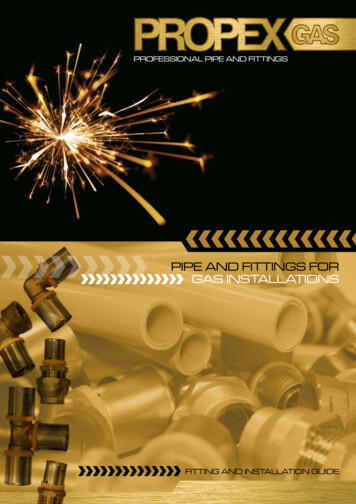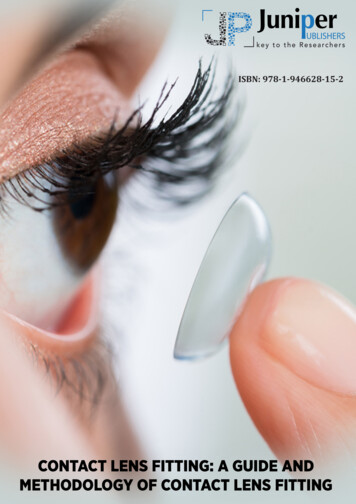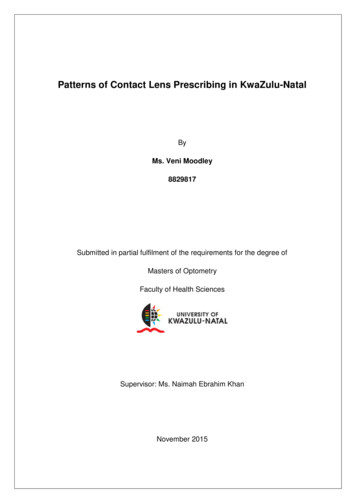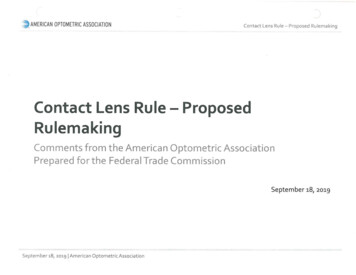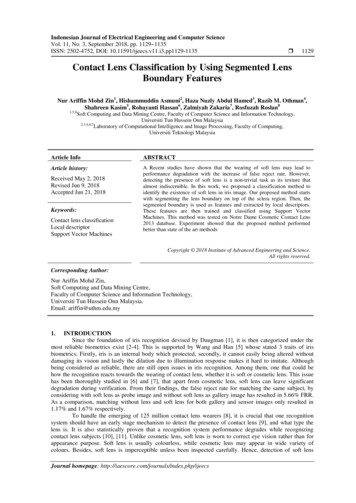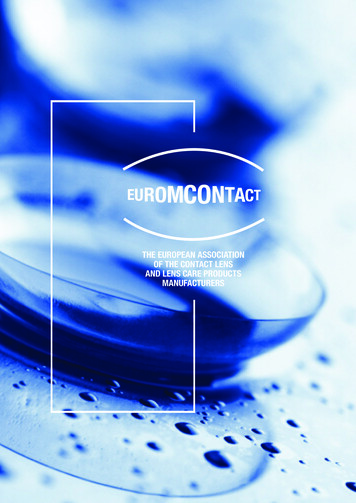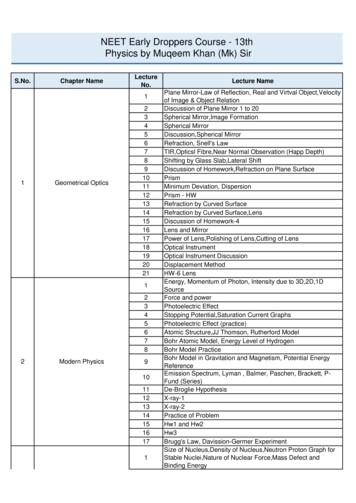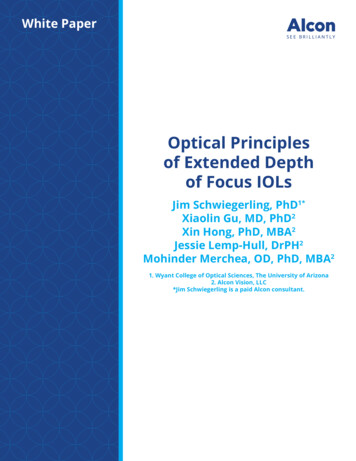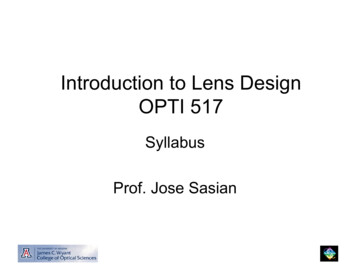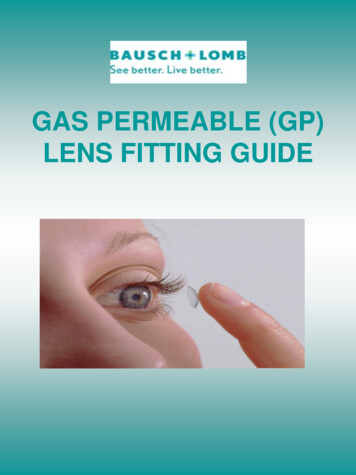
Transcription
GAS PERMEABLE (GP)LENS FITTING GUIDE
Bausch & Lomb provide a complete ‘Made to Order’service backed by personal service and technicaladvice.Our range of materials provide fitters with a complete choice to caterfor almost any patient requirementMaterialsInformationBOSTON XO2Hyper Dk Fluorosilicone AcrylateOutstanding oxygen permeability withoutcompromising wettability, stability, or comfort.Excellent deposit resistance.BOSTON XOSuper Dk Fluorosilicone AcrylateHigh Oxygen delivery, stability equalling that oflower Dk materials.QUANTUM II(ML210)Super Dk Fluorosilicone AcrylateHigh Oxygen Delivery. Good Protein resistance.BOSTON EOHigh Dk Fluorosilicone AcrylateExcellent wetting/deposit resistance.BOSTONEQUALENSHigh Dk Fluorosilicone AcrylateFluorinated polymer for improved oxygendelivery. Contains UV absorber.QUANTUM I(ML92)Mid Dk Fluorosilicone AcrylateMedium oxygen delivery. Good proteinresistance.BOSTON ESLow-Mid Dk FluorosiliconeAcrylateExceptional durability and modulus. Exceptionalwetting and deposit resistance.For more information on our GP range please visitwww.bauschgp.com or phone our dedicated GP specialistteam on 0870 850 7921
Fitting GuideMAXIMMaxim UltraSpheric GP Contact Lens Reaching New Heights of ExcellenceFEATURES Constant Average Thickness Constant tear layer profileBENEFITSAll lenses, regardless of power, have the same meanthickness value. This ensures consistent centrationand movement and the Dk/t is constant throughout thepower rangeMaintains a consistent fluoroscein pattern beneath thelens, regardless of K readings. Studies show high firstfit success rate, making the lens easy to fit whenempirical fitting. Spherical Optic ZoneBest possible optical quality To ensure first time successStraight forward empirical fittingTechnical InformationManufactureLathe CutMaterialsML92, ML210Boston ES, Boston Equalens, Boston EOBoston XO, Boston XO2Powers-25.00 to 25.00 (in 0.25D steps)Diameters9.30mm & 9.80mmAverage Thickness0.19mm (all powers)Base Curves (BOZR)7.00mm to 9.00mm (0.05mm steps)
Fitting GuideMAXIM ULTRAAspheric GP Contact Lens Reaching New Heights of ExcellenceFEATURES Constant Average Thickness Constant tear layer profileBENEFITSAll lenses, regardless of power, have the same meanthickness value. This ensures consistent centrationand movement and the Dk/t is constant throughout thepower rangeMaintains a consistent fluoroscein pattern beneath thelens, regardless of K readings. Studies show high firstfit success rate, making the lens easy to fit whenempirical fitting. Spherical Optic ZoneBest possible optical quality Aspheric peripheryOptimum comfort, adaptation, on eye dynamics Straight forward empirical fittingTo ensure first time successTechnical InformationManufactureLathe CutMaterialsML92, ML210Boston ES, Boston Equalens, Boston EO,Boston XO, Boston XO2Powers-25.00 to 25.00 (in 0.25D steps)Diameters9.30mm & 9.80mmAverage Thickness0.19mm (all powers)Base Curves (BOZR)7.00mm to 9.00mm (0.05mm steps)
Maxim UltraFittingGuideQUANTUM LensesUnique spheric/aspheric design. Consistently smooth transition zoneClear optics and good corneal alignment on a wide range of corneasMore accurate corneal alignment can be achieved. Even pressure andweight distribution combined with clear vision in all light levelsHigh levels of comfort and deposit resistance leads to excellent longterm patient satisfaction LENS K READINGS: should be measured in the usual way. FITTING SELECTION: The aspheric peripheral zone of Quantum produces a flatter fittingrelationship on the cornea than found with other rigid lens designs. This means that the optimallyfitting lens is frequently 0.05mm to 0.10mm steeper than the flattest corneal curve. The lens should demonstrate minimal apical clearance or alignment to the flatter meridian of the eye . FLUORESCEIN PATTERN: Although initially specifying a lens with a relatively steep Back OpticZone Radius (BOZR), the fluorescein pattern will show an alignment fit for optimal lens performance. PERIPHERAL FIT: Peripheral clearance should encroach up to 1mm in from the edge of the lens inthe flatter meridian but may be more in the steeper meridian in toric eyes.The lens should move adequately on blinks and eye movement but should not cross the limbuson extreme gaze. Adequate peripheral clearance should be maintained in all directions of gaze OVERALL SIZE: Select the 9.60mm diameter as the first choice, but ensure 1-1.5mm less than HVIDGENERAL GUIDANCEPoor centration may be improved with a larger diameter of 10.20BOZR can be increased to flatten the central fit or decreased to steeper the central fitTechnical InformationManufactureAspheric/Lathe CutMaterialsQuantum 1, Quantum 2, Boston XO2Powers-25.00 to 25.00 (in 0.25D steps)Diameters9.00mm & 9.60mm & 10.20mmBase Curves (BOZR)7.00mm to 8.80mm (0.05mm steps)
Maxim UltraFitting GuideMULTICURVE LensesConventional multicurve fitting is based on apical alignment withgradually increasing peripheral clearance. LENS K READINGS: should be measured in the usual way. SPHERICAL CORNEA: select initial lens on flattest K and assess fluorescein pattern andamend as necessary to provide minimal apical clearance. GP LENSES: to avoid flexure of GP materials on toric corneas it may be necessary to fit theselenses aligned to the flattest meridian. Consider full back toric if difference in K is greater than0.3 BCOD: should be large enough to cover the pupil in a good range of light levels. OVERALL SIZE: should be large enough for stability without overriding the limbus on extremeeye movements. PERIPHERAL CURVES: should be amended to change edge lift as required, depending onperipheral lens fit.GENERAL GUIDANCE(i) For each increase in BCOD of 0.50mm increase BCOR by 0.05mm.(ii) When steeping fit by 0.05mm change power by -0.25There should be minimal apical clearance with edge clearance just evident in themid-periphery increasing to the edge of the lensTechnical InformationManufactureLathe CutMaterialsML92, ML210Boston ES, Boston Equalens, Boston EOBoston XO
Maxim UltraFitting GuideZL9 Lens DesignThe fitting of ZL9 lenses does not depart significantly fromconventional multicurve fitting The aim is a well centred lens withminimal apical clearance and adequate peripheral clearance.The first lens is usually selected to be 0.05mm steeper than flattest KReading and the fluorescein pattern assessed. LENS K READINGS: should be measured in the usual way. SELECTION: first lens should be 0.05mm steeper than flatter K-reading. Assess fluoresceinpattern and amend as necessary to provide minimal apical clearance. GP LENSES: to avoid flexure of GP materials on toric corneas it may be necessary to fit theselenses aligned to the flattest meridian. Consider fill back toric if difference in K is greater than0.3 BCOD: should be large enough to cover the pupil in a good range of light levels. OVERALL SIZE: should be large enough for stability without overriding the limbus on extremeeye movements. PERIPHERAL FIT: While the rate of flattening is standardised more or less edge clearance canbe achieved by requesting the rate of flattening from a lens with a different BCOR (designated Zthe flattening factor) Eg BCOR 7.90 with 8.00 Z will give the peripheral curves of a lens of BCOR 8.00 i.e.more edge clearance EgBCOR 7.90 with 7.70 Z will give less edge clearance than stdGENERAL GUIDANCE(i)For each increase in BCOD of 0.50mm increase BCOR by 0.05mm.(ii)When steeping fit by 0.05mm change power by -0.25There should be minimal apical clearance with edge clearance just evident in themid-periphery increasing to the edge of the lensTechnical InformationManufactureLathe CutMaterialsML92, ML210Boston ES, Boston Equalens, Boston EO, Boston XO
Maxim UltraFitting GuideKERATACONUS Lens DesignA kerataconus lens is used on a misshapen cornea, usually having avery steep central radius. The BCOR of the lens is steep and the backoptic diameter is also smaller than standard. LENS K READINGS: should be measured in the usual way. SELECTION: After taking K Readings select initial lens BCOR to be one third of the differencebetween K’s steeper than flattest.EG: K’S 7.00x6.40 Initial lens 6.80 Flourescein pattern should a ‘bulls eye’ pattern e.g slight central touch, then clearance, touch,then peripheral clearance. Assess fit and over refraction and refine as necessary. Peripheries can be modified to givegreater or lesser edge clearanceGENERAL GUIDANCE(i)The steeper the BCOR the greater the edge clearance.(ii)All peripheral curves and diameters can be amended as required.Technical InformationManufactureLathe CutMaterialsML92, ML210Boston ES, Boston Equalens, Boston EO, Boston XOFITTING SETS ARE AVAILABLE ON REQUEST
Maxim UltraFitting GuideMAXIM TORIC LensesThe toric back surface made to match the patient's exact cornealgeometry means the first lens fits well, giving excellent vision withgood comfort. The fitting of toric lenses can be achieved from thecalculation of lens fit and prescription. LENS K READINGS: should be measured in the usual way. FITTING SELECTION: Select lens BCOR’s to match patient K readings to the nearest 0.05mm inboth meridians. Assess fit and residual refractive error. FLUORESCEIN PATTERN: Ideally the fit should be equivalent to a spherical lens on a sphericalcornea i.e. minimal spherical apical clearance and adequate edge lift. TORIC REFRACTIVE CORRECTION: If the lens is aligned to each meridian then the lens BVP oneach meridian should equate with the ocular refraction in each meridiane.g. K reading: 7.95 along 175 & 7.07 along 85Spec Rx: -3.00/-3.00 x 180Vertex Distance: 10mmLens ordered: 7.95 x 7.05/9.80/-3.00 along flat -5.75 along steep OVERALL SIZE: As a general rule, a larger diameter is preferable to a smaller diameter as lensstability and cent ration are improved. Normally 9.80GENERAL GUIDANCE(i)For each 0.05mm flatter than cornea 0.25D an extra increase plus power will be required.(ii)For each 0.05mm steeper then -0.25 an extra minus power will be required. This can beapplied to each meridian separately.(iii)In general the aim is a spherical type fit with good centration and adequate even edgeclearance around the lens.Technical InformationManufactureLathe CutMaterialsML92, ML210Boston ES, Boston Equalens, Boston EO,Boston XO, Boston XO2
Fitting GuideMAXIM VARIFOCALEnabling all existing wearers of Maxim & Maxim Ultra tocontinue with the same design when they become presbyopic,Providing a practical solution for all presbyopes new to the Maxim range.FEATURES True Varifocal Aspheric front surface Back Surface Spherical Optic Zone Back Surface Aspheric periphery Constant Average Thickness Constant tear layer profile Easy to fit Recommendations for fittingBENEFITSNo visible transition from distance to reading. Thepractical solution for new presbyopes.Centre Distance design .Generates reading addition. Norestriction on reading addition.Best possible optical qualityEasy fit from existing Maxim and Maxim Ultra patients.Optimum comfort, adaptation, on eye dynamicsAll lenses, regardless of power, have the same meanthickness value. This ensures consistent cent rationand movement and the Dk/t is constant throughout thepower rangeMaintains a consistent fluroscein pattern beneath thelens, regardless of K readings. Studies show high firstfit success rate, making the lens easy to fit whenempirical fitting.For existing Maxim range wearers simply provide currentspecifications & reading add . For new wearers empiricalfitting by supplying K readings, Spec Rx, & reading add.9.80mm diameter should be the first choice.The readingadd to be specified Px add plus 0.50DTechnical InformationManufactureLathe CutMaterialsML92, ML210Boston ES, Boston Equalens, Boston EO,Boston XO, Boston XO2Powers-25.00 to 25.00 (in 0.25D steps). Reading add toorder.Diameters9.30mm/ 9.80mm.Average Thickness0.19mm (all powers)Base Curves (BOZR)7.00mm to 9.00mm (0.05mm steps)
Maxim UltraFitting GuideREVERSE GEOMETRY DesignReverse geometry GP contact lens fitting is effective in correctingsurgically induced irregular corneas and with improved visual acuityand comfort. These lenses may be the best choice in cases in whichsurgical re treatment is unfeasible or undesirable. LENS K READINGS: post refractive K readings should be taken in the usual way and obtain thepre surgical Keratometry readings, or the pre op prescription which can help us determine thereverse curve The lens should demonstrate a unique bulls-eye fit similar to a keratoconus fit The central zone should be in virtual alignment to the central cornea or very slightlyapically steep The transition zone will show annulus of fluorescein surrounding the central area of alignment The mid-peripheral junction should show alignment to the mid-peripheral cornea andthere should then be adequate peripheral clearance Central fit can be modified by steepening or flattening the BOZR MTO lenses made from computer assisted design programs can be supplied to individualrequirementsTechnical InformationManufactureLathe CutMaterialsML92Powers-20.00 to 20.00 (in 0.25D steps)DiametersTo SpecificationBase Curves (BOZR)7.00mm to 9.00mm (0.05mm steps)
Lens Fitting ExamplesFluorescein PatternTypically, the fluorescein pattern of the final lens should show some mildapical bearing (“feather” touch) or alignment and the absence ofperipheral bearing over more than 180 of its circumference. Excessiveapical pooling or bearing should be avoided. A moderate edge lift isnecessary to permit the edge of the lens to slide over the corneal surfacewith minimal resistance.Alignment FitFlat FitSteep FitSpherical lens ontoric cornea
General GuideFOR BAUSCH & LOMB GP CONTACT LENSESImportant: This information should be explained to the patientwhen supplied with Bausch & Lomb Contact LensesINTENDED USEBausch & Lomb Contact Lenses can be prescribed for the correction of vision defects includingmyopia, hyperopia, presbyopia, aphakia, non-aphakia and astigmatism.LENS CARE PROCEDURESBausch & Lomb recommends that Bausch & Lomb lens care products be used with Bausch & LombContact Lenses. Please refer to the appropriate guide for details. The practitioner should recommenda care system to the patient for the lenses. For whatever system is selected, the instructions whichaccompany these care products must be explained to the patient. Gas Permeable lenses are providedpre-soaked in Boston wetting and soaking solution.CONTRAINDICATIONSUse your professional judgement and experience in evaluating patient of ocular suitability for contactlenses. In addition, Bausch & Lomb lenses are contraindicated when the following conditions exist:Unhealthy patient eyes.History of patient non-compliance with contact lens care and disinfection regimes, wearing restrictions,wearing schedule, or follow-up visit schedule.Patient inability or unwillingness, because of age, infirmity or other mental or physical conditions, or anadverse working of living environment, to understand or comply with any warning, precautions,restrictions or directions.WARNINGSAfter a thorough eye examination, including appropriate medical background, patients should be fullyappraised by the prescribing practioner of all the risks with contact lens wear. Patients should beadvised of the following warnings pertaining to contact lens wear:Problems with contact lenses and lens care products could result in serious injury to the eye. It isessential that patients follow their eye care practitioners direction and all labelling instructions forproper use of lenses and lens care products, including the lens case. Eye problems, including cornealulcers, can develop rapidly and lead to loss of vision.When prescribed for the Frequent Replacement Programme, the need for strict compliance and careregime including cleaning of the lens case, wearing restrictions, wearing schedule, and follow-up visitschedule should be emphasised to the patientStudies have shown that contact lens wearers who are smokers have a higher incidence of adversereactions than non-smokers
General GuideFOR BAUSCH & LOMB GP CONTACT LENSESPRECAUTIONSIf a patient experiences eye discomfort, excessive tearing, vision changes, or redness of the eyethe patient should be instructed to immediately remove lenses and promptly contact his of her eye carepractitioner.Contact lens wear may not be suitable for certain occupations or in other instances may require eyeprotection equipmentEnvironmental fumes, smoke, dust, vapours and windy conditions must be avoided in order to minimisethe chances of lens contamination or physical trauma to the corneaHard and rigid gas permeable contact lens solutions, not indicated for use with soft lenses, may not beused in the soft lens care system. RGP lens solutions should not be used with soft lenses.Serious corneal injury may result from mismatching lens and solutions types.Eye injury from irritation or infection and damage to lenses may result if cosmetics, lotions, soaps, creams,hairspray or deodorants come into contact with lenses.Tweezersof other tools should not be used by patients to remove a lens from a container. The lens should.be poured into the hand or removed with a finger. Patients must be instructed on and demonstrate the abilityto promptly remove the lens from their eyes.ADVERSE EFFECTSThe following symptoms may occur; Eye pain Eye sting, burn or itch (irritation) Comfort is less than when lens was first placed on eye Feeling of something in the eye (foreign body, scratched area) Excessive watering (tearing) of the eye Unusual eye secretions Redness of the eyes Reduced sharpness of vision (poor visual acuity) Blurred vision, rainbows or haloes around objects Change in sensitivity to light (photophobia) Feeling of drynessThe patient should be instructed that if any of the above symptoms occur they should; Immediately remove the lens If the discomfort or problems stop, then look closely at the lens If the lens is in anyway damaged, do not put the lens back in the eye. Place the lens in the storagecase and contact the eye care practitioner If the lens has dirt, an eyelash of other foreign body on it, of the problem stops and the lens appearsundamaged, thoroughly clean, rinse and disinfect the lens, then re-insert it If the above symptoms continue after removal of the lens or recur upon insertion of the lens, the lensshould be removed immediately and the patient should contact their eye care practitioner or aphysician, who must determine the need for examination, treatment or referral without delay
For All Technical GPQueriesTelephone B&L Hastings0870 8507921
Aspheric periphery Optimum comfort, adaptation, on eye dynamics Straight forward empirical fitting To ensure first time success Manufacture Lathe Cut Materials ML92, ML210 Boston ES, Boston Equalens, Boston EO, Boston XO, Boston XO2 Powers -25.00 to 25.00 (in 0.25D steps) Diameters 9.30mm & 9.80mm
